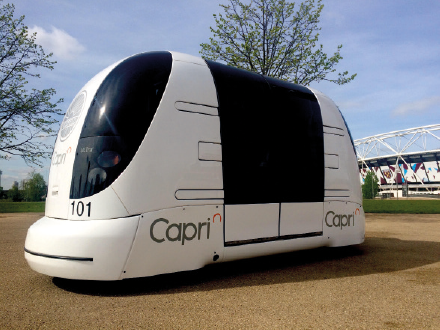Testing connected and autonomous vehicles doesn’t begin on the road – the latest modeling software can create accurate virtual worlds that enable vehicle manufacturers and traffic managers to explore the limits of the technology in order to enable safer real-world deployment.
The prospect of the widespread use of connected and autonomous vehicles (CAVs) is drawing closer, and the role of simulation in transportation planning, design and engineering has never been more vital. In an arena with so many unknowns, simulation is perfectly suited to testing: it provides a safe, risk-free environment that is extensible and flexible enough to cope with changing parameters and a multitude of variables, but that also has the power to analyze many scenarios in a matter of minutes.
There are two main perspectives on this: vehicle manufacturers want to use simulation as a debugging environment, to run virtual tests with software- and hardware-inthe- loop, to see how their products are going to perform in the network; public administrators want to test the impact of that technology and forecast the consequent changes and investments in mobility management. Both want to test these connected vehicle developments under different road traffic conditions, where there might be incidents of different proportions of CAVs in the national fleet, and establish what might happen if transmission becomes less reliable. All of these are hard to test on the road at present, but can be tested in simulation.
Software solutions
Aimsun Next software provides a set of tools for investigation into the use of vehicle-to-everything (V2X) connectivity. The new, extensible V2X Software Development Kit (V2X SDK) can help researchers design innovative systems based around connected vehicles and enable them to test future urban traffic management systems, in-car information tools and autonomous vehicle controls. The V2X SDK features the most common V2X message types defined in EU or North America (protocols such as CAM – Cooperative Awareness Message; DENM – Decentralized Environmental Notification; and SPaT – Signal Phase and Timing) and allows the adjustment of transmission range and probability of successful transmission that simulates the physical and network layers of a Vehicle Ad-hoc Network (VANet). This makes it possible to test virtually any connected vehicle application, implementing the resulting actions at the level of a single vehicle, the immediate vicinity, or even network-wide.

The V2X SDK is designed to be readily extended to add new technologies and messages as they emerge; an environment with the flexibility to work with vehicle behavior that ranges from detailed collaboration between connected and autonomous vehicles, to showing a driver information in the hope of eliciting a reaction. You only have to write some code for the onboard units (OBU), for the roadside units (RSU) and/or for the traffic management center (TMC) that, at every time step in the simulation, processes the list of messages received by each device, and defines the action to take (e.g. for an OBU, set the speed of the vehicle; for an RSU, change the duration of the current phase; for a TMC, provide a route to an emergency vehicle).
The simulation also needs to operate at different scales. In one scenario, a modeler may want close-up detail for a single intersection, to test how fast driverless vehicles can pass through. Then, in another scenario, the modeler may want to test pollution levels using data aggregation across a large network. Modeling at an appropriate scale, from a single junction to a city-wide road network, is an important part of what Aimsun Next is able to do with integrated macro-, mesoand micro-models. The design of the V2X SDK in Aimsun Next, with its inherent extensibility and flexibility, is just a part of the same philosophy.
CAV pilot projectsInnovate UK is funding three major CAV pilots using Aimsun software
Aimsun’s new V2X SDK modeling software was developed within the Innovate UK Flourish project.
This is a three-year, £5.5m (US$7.7m) project launched in June 2016 that is very much focused on CAVs in an urban environment, seeking to develop products and services that maximize the benefits of CAVs for users and transportation authorities.
A second CAV project, led by Aecom in the UK, is called Connected & Autonomous Pod on-Road Implementation (CAPRI). CAPRI aims to design, develop and test a connected and autonomous pod for moving people around airports, hospitals, business parks, and shopping centers, but will also test how the network can harness data to enable location, positioning and on-demand services. It is anticipated that evidence collected through the pilot will provide sufficient detail to enable and support a new vehicle classification for the pods.
In addition to impact assessment and assisting in the design of management strategies for the use of pods at the Olympic Park in London, Aimsun will also be playing a role in the verification and validation of the pod control systems, enabling safety evaluations in a controlled, risk-free virtual environment.
A third UK CAV project is HumanDrive, within which Aimsun is simulating the effects of autonomous vehicles in mixed traffic (that is, cars with and without drivers) on the strategic road network. This 30-month autonomous vehicle project is led by Nissan’s Technical Centre Europe, as a part of Renault-Nissan Alliance research activities, and will culminate in the most complex journey yet attempted across the UK without driver input. The HumanDrive vehicle will deal with a variety of UK driving scenarios, including country roads, high-speed roundabouts, A roads, and highways in live traffic and in different environmental conditions.
The Aimsun Next simulation environment will be used to evaluate the performance of different types of CAVs along with strategies for their use and management; this will not only help with understanding of their impact on capacity, but also on emissions and safety.
Words | Gavin Jackman, Aimsun, Spain







